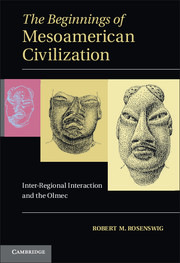Book contents
- Frontmatter
- Contents
- Figures
- Tables
- Acknowledgments
- SECTION I AN EARLY FORMATIVE MESOAMERICAN PROBLEM
- SECTION II ARCHAEOLOGICAL DATA
- 4 Settlement Patterns and Architecture
- 5 Diet, Food Processing and Feasting
- 6 Representation and Aesthetics
- 7 Inter-regional Exchange Patterns
- SECTION III DERIVING MEANING FROM THE ARCHAEOLOGICAL RECORD
- 9 Conclusion
- Appendix 1 Temporally secure excavation contexts at Cuauhtémoc with detailed ceramic data
- Appendix 2 Temporally secure excavation contexts at Cuauhtémoc without detailed ceramic data
- References Cited
- Index
7 - Inter-regional Exchange Patterns
Published online by Cambridge University Press: 26 February 2010
- Frontmatter
- Contents
- Figures
- Tables
- Acknowledgments
- SECTION I AN EARLY FORMATIVE MESOAMERICAN PROBLEM
- SECTION II ARCHAEOLOGICAL DATA
- 4 Settlement Patterns and Architecture
- 5 Diet, Food Processing and Feasting
- 6 Representation and Aesthetics
- 7 Inter-regional Exchange Patterns
- SECTION III DERIVING MEANING FROM THE ARCHAEOLOGICAL RECORD
- 9 Conclusion
- Appendix 1 Temporally secure excavation contexts at Cuauhtémoc with detailed ceramic data
- Appendix 2 Temporally secure excavation contexts at Cuauhtémoc without detailed ceramic data
- References Cited
- Index
Summary
I also hope that I will not be held to have been overambitious for having felt the need and the desire for taking a wide view. Surely history need not simply be condemned to the study of well-walled gardens?
Braudel 1980 [1966]: 4The exchange of goods and ideas between regions is an important, and distinctly human, form of interaction. Exchange is defined here in the widest sense with no necessary assumption of the mechanisms through which objects were moved (Renfrew 1977: 72; Wright 1989: 268). Inter-regional exchange has long been linked to the emergence of sociopolitical ranking through resource exchange (Renfrew and Shennan 1982), craft specialization (Brumfiel and Earle 1987) and the control of esoteric knowledge (Helms 1979). Shelach (1999: 17–24) has made a case for the false dichotomy between processes internal and external to a given society and argues that both geographical scales must be integrated to understand the entirety of sociopolitical change. This argument is consistent with the core-periphery perspective discussed in Chapter 2 that addresses regional Mesoamerican processes to understand local developments at Cuauhtémoc. Although the degree to which inter-regional exchange accounts for local change can be challenging to demonstrate, the alternative – as Braudel notes – is to study small, well-walled gardens and miss the big picture.
Patterns of inter-regional exchange during Mesoamerica's Formative period have received considerable attention over the years.
- Type
- Chapter
- Information
- The Beginnings of Mesoamerican CivilizationInter-Regional Interaction and the Olmec, pp. 227 - 256Publisher: Cambridge University PressPrint publication year: 2009



